Russian emblem. What are state symbols and how did they arise
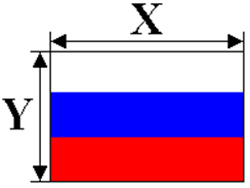
Government of the Tyumen region
Heraldic Council of the Tyumen Region
Tyumen
2009
Introduction
SECTION 1. STATE FLAG
1.1. DESCRIPTION OF THE STATE FLAG
1.2 BASIC RECOMMENDATIONS FOR THE USE OF THE STATE FLAG
1.3. SOME GENERAL REQUIREMENTS AND TOLERANCES FOR USING THE STATE FLAG
1.4. TECHNICAL ISSUES OF USING THE STATE FLAG
1.4.1 GLOSSARY
1.4.2 TECHNICAL REQUIREMENTS
1.4.3. PROCEDURE FOR LIFTING (POSTING, INSTALLATION) OF FLAGS
1.4.4. LOCATION OF SEVERAL FLAGS TOGETHER
1.4.5. PERMANENT POSITION OF THE STATE FLAG IN THE PREMISES
1.4.6. STATE FLAG OF THE RUSSIAN FEDERATION ON VEHICLES
1.4.7. USE OF THE STATE FLAG DURING OFFICIAL CEREMONIES AND FESTIVAL EVENTS
1.4.8. OTHER TYPES OF PLACING FLAGS
SECTION 2. STATE EMBLEM
2.1 DESCRIPTION OF THE STATE COAT OF ARMS
2.2.1. MANDATORY CASES OF USE OF THE STATE EMBLEM
2.2.2. ALLOWED USE OF THE STATE EMBLEM
2.2.3. UNACCEPTABLE CASES OF USING THE STATE EMBLEM
2.3. GENERAL COMMENTS ON THE IMAGE OF THE STATE COAT OF ARMS
2.4. TECHNICAL ISSUES OF USING THE STATE COAT OF ARMS
2.4.1. PLACING THE STATE COAT OF ARMS ON THE BUILDINGS
Section 3. The National Anthem
3.1. GLOSSARY
3.2. FROM THE HISTORY OF THE STATE HYMN OF THE RUSSIAN FEDERATION
3.3. BASIC RECOMMENDATIONS FOR THE USE OF THE STATE ANTHEM OF THE RUSSIAN FEDERATION
3.3.1. MUSICAL EDITORS OF AN ANTHEM, WAYS OF PERFORMING AN ANTHEM IN OFFICIAL SITUATIONS
3.3.2. CASES OF PERFORMANCE OF THE STATE HYMN
3.3.3. STANDARDS OF BEHAVIOR DURING PERFORMANCE OF THE STATE HYMN
Introduction
Official state symbols Russia are the most important attributes of state sovereignty. Respect for state symbols, possession of the basics of their proper use serve as indicators of both general and political culture in society.
State symbols reflect the centuries-old history of the Fatherland, the connection of the present with the past and landmarks for the future. The education of respect and love for the symbols of the state, their correct use is the most important direction in the formation of patriotic consciousness of citizens.
Issues of development, creation, use, etc. State and other symbols are the prerogative of the science of heraldry. Heraldry in this broad sense is the practice of creating and using decals.
Heraldry is based on the basic rules that have developed spontaneously during centuries of practical use.
Creation and use of emblems and other signs is only harmonious, efficient and effective when in this process formal rules and historical tradition are correctly combined, complement and develop each other.
In world practice, there is a trinity of official distinctive symbols of the state: the State flag, the State emblem and the National anthem.
The procedure for using each of the state symbols is determined by the relevant federal constitutional law. In accordance with world practice, state symbols Russian Federation are:
- State flag of the Russian Federation (approved by the Federal Constitutional Law of the Russian Federation “On the State Flag of the Russian Federation of December 25, 2000 No. 1-FKZ);
- State Emblem of the Russian Federation (approved by the Federal Constitutional Law of the Russian Federation “On the State Emblem of the Russian Federation of December 25, 2000 No. 2-FKZ);
- The National Anthem of the Russian Federation (approved by the Federal Constitutional Law of the Russian Federation “On the National Anthem of the Russian Federation of December 25, 2000 No. 3-FKZ).
State symbols of the Russian Federation are symbols of the Russian state, its sovereignty, unity and unity of its citizens. In this regard, state symbols should be used in accordance with its meaning:
For state labeling; is a manifestation of state power and state powers, that which is equally necessary for all citizens of the country;
To demonstrate the unity and cohesion of citizens, of general significance for this or that action for the whole of Russia;
To represent Russia in the international arena.
There are differences in the practice of their use, it depends on the specific traditional place occupied by the flag, coat of arms and anthem in the practice of stateof life. The flag to a greater extent represents a certain national national symbol, so the practice of its application is wide enough, it has more freedom to use than the coat of arms. This is because the emblem has always been and is a symbol of the state and state power.
No one has the right to authorize or prescribe the use of any of the state symbols, if such use is not provided for or is prohibited by the relevant law. In cases where the use of any of the state symbols is prescribed by the relevant law or recognized by the law as permissible, the use of the corresponding state symbol does not require requesting or obtaining permission from any authority.
Section 1. State Flag
1.1. DESCRIPTION OF THE STATE FLAG
The national flag of the Russian Federation is a rectangular panel of three equal horizontal stripes: the upper - white, middle - blue and lower - red. The ratio of the width of the flag to its length is 2: 3.
Fig. 1. Image of the Russian flag
It is absolutely unacceptable to use the flag in the reverse arrangement of the stripes.
Although the Law on the National Flag leaves the possibility of certain liberties in using the flag, the manifest respect for the flag on the part of official users - federal executive bodies and state authorities of the constituent entities of the Russian Federation - is strict adherence to the law, the desire to avoid unnecessary, unlawful replication of the flag and on the other hand, the clear use of the flag in cases provided for by law. Liberties are permissible for private citizens, to a lesser extent - organizations, institutions and enterprises.
In the activities of the federal executive bodies and public authorities of the constituent entities of the Russian Federation, the flag should not be allowed to stay permanently in places where this is not prescribed by law (for example, in the offices of deputy heads of such bodies, in vehicles, for public authorities of constituent entities of the Russian Federation - non-state level building units.
The guiding principle here should be the provision:
The constantly raised (set) State flag indicates a building (office) in which the functions of the federal state power are carried out or the authorities and institutions exercise their powers, which, in accordance with federal law, are given the functions to exercise state power of the constituent entities of the Russian Federation;
- a temporarily raised (hung, set) flag indicates a particularly important event, an official ceremony, a major celebration taking place in the place (building, territory) where the flag is temporarily raised.
The Federal Constitutional Law “On the State Flag of the Russian Federation” establishes the cases of mandatory, permissible and unacceptable use of the State Flag:
- Mandatory use of the National Flag:
The national flag of the Russian Federation must be:
1) it is constantly raised (alone or together with the corresponding flags) on the buildings of the federal executive bodies;
2) is permanently installed in the offices of the heads of federal executive bodies;
3) raised (installed) when the federal executive authorities held official ceremonies and other special occasions.
For public authorities of the constituent entities of the Russian Federation and local self-government:
The national flag of the Russian Federation must be:
1) constantly raised on the buildings of state authorities of the constituent entities of the Russian Federation and local authorities;
2) is installed permanently in the offices of the heads of state authorities of the constituent entities of the Russian Federation and heads of municipalities; in the meeting rooms of legislative (representative) bodies of state power of the constituent entities of the Russian Federation, supreme executive bodies of state power of the constituent entities of the Russian Federation, as well as representative bodies of local self-government.
3) raised (installed) during official ceremonies and other special occasions.
- Allowed use of the National Flag:
For federal executive authorities:
the image of the State flag of the Russian Federation can be used as an element or heraldic basis for emblems and flags of federal executive bodies of the Russian Federation.
- Inadmissible cases of using the National Flag:
Not allowed:
1) abuse of the State flag;
2) the use of a distorted flag, i.e. a flag made in violation of the established description (non-compliance with the aspect ratio, strip arrangement, strip width, placing any images and inscriptions on the flag, etc.);
3) violation of the rules for placing the State Flag in combination with other flags.
Not allowed:
1) the identity of the flag of the subject of the Russian Federation, municipality and any other flag to the State flag;
2) the use of the State flag as the heraldic basis of the flags of the constituent entities of the Russian Federation, municipalities, public associations, enterprises, institutions and organizations, regardless of ownership.
1.3. SOME GENERAL REQUIREMENTS AND TOLERANCES FOR USING A STATE FLAG.
1. The national flag must be constantly raised at the residences of the plenipotentiaries of the President of the Russian Federation in the federal districts and permanently installed in the offices of the plenipotentiaries of the President of the Russian Federation in the federal districts.
2. On public holidays, the State flag is hoisted above the buildings or hung on the buildings of self-government bodies of municipalities, organizations, institutions and enterprises of all forms of ownership, on residential buildings.
3. When conducting informal celebrations and ceremonies by state authorities of the constituent entities of the Russian Federation, municipalities, as well as all types of celebrations organized by organizations, institutions, enterprises and private citizens, the establishment (raising, hanging of the State flag) is allowed.
4. In the days of mourning (both state and declared in the territory of the subject of the Russian Federation, municipality, in the organization, institution, enterprise, on the building (in the territory) of which the flag is raised (hung, set), the State flag:
- or it is lowered to half the shaft (flagpole, mast);
- either (if the flag is fixed on the flagpole motionlessly) a black ribbon is attached to the upper part of the flagpole, equal in length to the flag's flag (in the place of attachment to the flagpole the ribbon is folded in half).
1.4. TECHNICAL ISSUES OF USE OF THE STATE FLAG.
1.4.1 GLOSSARY
The flag is called the flag itself. It is the banner that plays a significant role, the banner is honored and respected.
The banner is historically the oldest form of the heraldic sign in the form of a banner and, in this sense, the flag is a type of banner. However, a specific meaning has now been established behind the word “banner”: a banner is a heraldic sign consisting of a panel and a number of other elements (a pole, top, nails, etc.) existing in a single copy, which is the main symbol of a narrow corporation (primarily - military unit) and playing the role of a particularly revered, worshiped and protected symbol. Banners are issued once and are not subject to change, even if the corporation whose symbol is the banner breaks up (for example, the military unit is disbanded), the banner is still surrounded by honor and respect (usually - it is transferred to the museum for eternal storage, it can be handed over in a particularly solemn atmosphere new corporation, created on the basis of the abolished corporation, etc.).
To name the State flag of the Russian Federation, the flags of the federal executive authorities, constituent entities of the Russian Federation, municipalities and other banners means to make a grave mistake!
The mast (flagpole) means of fastening the flag (usually in the form of a straight rod), mounted vertically or at an acute angle to the horizontal plane. The flag is attached to the mast (flagpole) on a movable joint - that is, structures made of cables stretched on blocks, allowing the flag to be raised and lowered. When raising the flag on the masts, it must be ensured that the flag is hoisted to the very top of the mast.
The flagpole is a means of fastening the flag (usually in the form of a straight rod), to the top of which the flag is fixed (by nailing, gluing, etc.). Flags on poles are used for hanging on buildings, for indoor installation, for carrying in hands.
The top is the decoration of the upper part of the flagpole, usually in the form of a metal (plastic, other) tube (worn on the upper end of the flagpole), to which the ornament itself is attached most often in the form of a decorative spear or a sculptural image. The top is a traditional subject of znamenny practice, and the use of the top for flags is undesirable (with rare exceptions - for example, in the case of setting the flag in the room). The tops are completely unacceptable on the masts (flag poles), this does not meet the international customs of flag practice, and, in addition, creates a visual effect that the flag is lowered - that is, it is located as it should during mourning days.
Raise the flag - use the flag with the mast (flagpole).
Hang a flag - put a flag fixed on a flagpole on the wall of a building, a room at an acute angle to a horizontal plane, or put a flag without a flagpole: stretched along the wall, fixed to the ceiling, of another engineering structure.
Set flag - place a flag fixed on a pole on a horizontal plane.
The width of the flag is the vertical size of the banner. (The term “flag height” is also sometimes used.)
The length of the flag is the horizontal size of the banner.
Fig. 2. Flag options.
X - flag length
Y - flag width 
1.4.2. TECHNICAL REQUIREMENTS:
Flags of flags can be made of any kind of fabric, as well as, in some cases, of paper and other flexible materials.
A technical strip of material other than the panel itself may be attached to the side of the panel intended for fastening, on which there may be holes, hooks, and other technical elements. It is desirable that the technical strip be the same colors as the banner, but it is permissible that it has a different color, but in this case, strive to ensure that the width of the technical strip is extremely small so that when raising (hanging) a flag with such a strip the strip did not give the observer the impression of a special heraldic part of the flag.
The colors of the flag stripes are defined as white, blue, and red. Shades of colors are established by the state standard.
Flag sizes are not set - the flag can be made of any size, depending on why and how it is used. It is strictly necessary to adhere to the ratio of the width and length of the flag: no matter what size the flag is made, this ratio should always be 2: 3.
1.4.3. PROCEDURE FOR LIFTING (POSTING, INSTALLATION) OF FLAGS
General requirements:
- Flag on the mast (flagpole).
The flag should be raised as high as possible (as close as possible to the upper end of the mast).
The mast is not allowed to top.
As a sign of mourning, the flag lowers to half the mast height.
Fig. 3. Flag on the mast (flagpole).
A - the correct location of the flag on the mast;
B - incorrect flag position on the mast;
C - flag lowered as a sign of mourning (X - mast height). 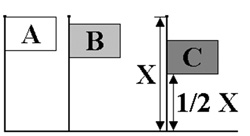
Masts (flagpoles) can be located:
On the ground, on the roof of the building - vertically,
-on the wall of the building (structure) - at an acute angle to the horizontal plane,
-on the wall of the building (structure) parallel to the horizontal plane;
- on ships - vertically, with a slight inclination to the horizontal plane.
Masts (flagpoles) cannot be located on the wall of a building (structure) at an obtuse angle to the horizontal plane.
Fig. 4. Options for the location of the mast (flagpole) on the wall of the building (structure).
A, B are valid options;
C is an invalid option.

- Flag on a pole.
The flag is fixed extremely close to the upper edge of the pole.
The top is undesirable.
The length of the shaft should not be less than the width of the cloth, multiplied by 2.
When hanging flags on a flagpole on a building’s wall, the flagpole should be located relatively to a horizontal plane, according to the same rules as described for masts (flagpoles).
When flags are mounted on a flagpole on a horizontal plane (ground, floor of the room, table surface, etc.), the flagpole can be either perpendicular to the horizontal plane or at an angle to it (at least 60 degrees).

A B C
A - valid flag locations for one flagpole;
In - valid options for the location of two flags in one slot;
C - valid options for the location of three flags in one slot.
- Flag without a pole, mast (flagpole).
The flag can be hung without a pole - in the form of a single panel. In this case, the banner can be:
- stretched on the wall (i.e. tightly attached to a vertical surface);
- suspended from the ceiling of a room or structure (or to any engineering structure at the top of the room or structure).
When hanging without a flagpole, the flag can be located horizontally (that is, the flag stripes are parallel to the horizontal plane) or vertically (the flag stripes are perpendicular to the horizontal plane).
! In the latter case (including if the flag is stretched on the wall), the white strip of the cloth should be on the left from the point of view of the one facing the flag.
Fig. 5. Options for hanging a flag without a flagpole:
a) horizontally:
B) vertically:
Taboo: in no case should a flag or banner touch the ground, even the edge. You can’t put a flag in the grave.
1.4.4. LOCATION OF SEVERAL FLAGS TOGETHER
The principle applies to all flagging cases.
Legislative requirements:
According to the Law on the State Flag, when placing the State Flag together with other flags, the State Flag of the Russian Federation must be located:
With an odd number of flags - in the center;
- with an even number of flags - to the left of the center (in terms of standing facing the flags).
The size of the flag of the State flag may not be less than the size of the flag of other flags placed next to it.
The state flag of the Russian Federation may not be located below other flags placed next to it.
Explanations
All flags have a certain status, more or less high depending on who these flags belong to.
When several flags are placed together, places of a more or less high value are distinguished. Accordingly, a flag of a higher status should be placed in the first place in value, a flag of a lower status in the place of the second largest and so on.
The highest value is given to the top, center (with an odd number of flags) and the left side of the center (with an even number) of the flags complex.
The status of flags is determined by the following order (in descending order from the highest status to the lowest):
Flags of international organizations;
- state flags;
- symbol of the Banner of Victory;
- state naval and civilian flags (for those countries in which such flags are available);
- flags of the federal executive authorities of the Russian Federation;
- flags of the constituent entities of the Russian Federation;
- flags of municipalities;
- flags of organizations, enterprises, associations;
- other flags (including those not officially approved and decorative).
Invalid:
In order for the lower status flag to be higher than the highest status flag (but at the same time any flags can be on the same vertical level and their location (for example, on flagpoles of the same height) is quite welcome) .It must be remembered that if the lower status flag is raised on the roof of the building, then a flag of the highest status cannot be hung on the wall of this building;
- so that the flag of the lowest status is closer to the center (with an odd number of flags) or to the left (with an even number of flags) than the flag of the highest status;
- so that the size of the flag of the lower status flag is larger than the adjacent high status flag.
Fig. 6. Schemes of the possible location of flags (status is shown by numbers: 1 - highest status, 2 - following it, etc.):
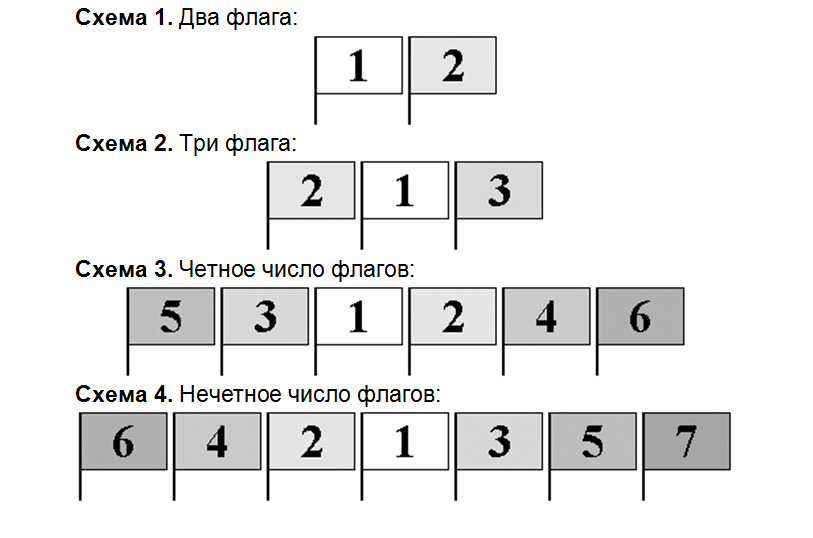
When placing equivalent flags, their positions are determined in alphabetical order from left to right.
1.4.5. PERMANENT POSITION OF THE STATE FLAG IN THE PREMISES
The national flag is constantly placed in the halls:
- meetings of the supreme bodies of state power of the Russian Federation;
- court hearings;
- meetings of state authorities of the constituent entities of the Russian Federation;
- meetings of representative bodies of local government.
The national flag (flags) in the hall are placed behind the presidium.
The national flag is constantly placed in the offices:
- The President of the Russian Federation (together with the standard of the President of the Russian Federation);
- heads of the supreme bodies of state power of the Russian Federation and other supreme state bodies of the Russian Federation;
- heads of federal executive bodies of the Russian Federation;
- federal judges and prosecutors;
- heads of government bodies of the constituent entities of the Russian Federation;
- heads of municipalities;
- heads of official representations of the Russian Federation outside the Russian Federation.
In the office, the flag is placed behind the head of the head to his right.
The location of flags in the offices of the official:
Fig. 7. Option 1.
![]()
Option 2
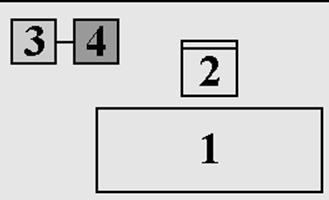
1 - the desktop of an official;
2 - a chair (chair) of an official;
3 - State flag of the Russian Federation;
4 - flag of the subject of the Russian Federation;
- the location of the walls of the office.
When installing the State flag in the premises, the following requirements must be observed:
- the flag should not touch the floor;
- the flag must fully comply with the figure approved by the Federal Constitutional Law "On the State Flag of the Russian Federation", not have fringe on the cloth;
- instead of using the national flag, the standard of the President of the Russian Federation cannot be used, which often happens in the offices of leaders of various ranks.
When using miniature copies of the State Flag and other flags together, the order of their mutual arrangement is similar to that described in these recommendations.
1.4.6. STATE FLAG OF THE RUSSIAN FEDERATION ON VEHICLES
The national flag of the Russian Federation is placed on vehicles of the President of the Russian Federation, the Chairman of the Council of the Federation of the Federal Assembly of the Russian Federation, the Chairman of the State Duma of the Federal Assembly of the Russian Federation, the Chairman of the Government of the Russian Federation, heads of state and government delegations, heads of official representations of the Russian Federation outside the Russian Federation.
At the same time, the State flag on cars is set in front, on the right side.
1.4.7. USE OF THE STATE FLAG DURING OFFICIAL CEREMONIES AND FESTIVAL EVENTS
The state flag of the Russian Federation is set (hung):
in rooms intended for ceremonies (ceremonies) with the participation of the President of the Russian Federation;
during ceremonies conducted by federal government bodies, government bodies of constituent entities of the Russian Federation and local authorities.
It is allowed to use the State Flag of the Russian Federation during celebrations held by public associations, enterprises, institutions and organizations regardless of ownership, as well as during family celebrations.
When solemnly bringing (carrying) the State flag to the place (from the place) of events, ceremonies together with other flags (banners), it is necessary to observe the subordination:
when following the banner groups (denominators with assistants) in the column one at a time - the State flag is located in front of other flags and banners;
when following the banner groups in the line - the State flag of the Russian Federation is located in accordance with the above procedure (clause 1.4.4.).
1.4.8. OTHER TYPES OF PLACING FLAGS
Temporary placement (hanging, hoisting) of the State flag of the Russian Federation is carried out on buildings (or near them) of public associations, enterprises, institutions and organizations, regardless of ownership, as well as on residential buildings on public holidays.
In this case, the State flag may be placed together with other flags (symbol of the Banner of Victory, flags of federal executive authorities, flags of the constituent entities of the Russian Federation, flags of municipalities, etc.).
Requirements for the placement of other flags in conjunction with the State Flag are similar to the above (paragraph 1.4.4.).
During international negotiations, official meetings and other similar events in which the Russian side is the host, the principle of hospitality applies, according to which the flag (flags) of the host side takes pride of place.
If the event is held within the framework of an international organization, then its flag takes priority over the flags of the member states of the organization.
In the event that a large number of foreign delegations of equal status participate in the event, state flags are placed in the sequence determined in accordance with the Latin alphabet, from left to right, if you face them.
Section 2. State emblem
2.1 DESCRIPTION OF THE STATE COAT OF ARMS
The State Emblem of the Russian Federation is a quadrangular, with rounded lower corners, pointed at the tip of a red heraldic shield with a golden double-headed eagle, which raised its spread wings. The eagle is crowned with two small crowns and - above them - one large crown connected by a ribbon. In the right paw of the eagle is the scepter, in the left - the power. On the chest of the eagle, in a red shield, is a silver rider in a blue cloak on a silver horse, striking with a silver spear a black overturned backward and trampled by a dragon horse.
Reproduction of the State Emblem of the Russian Federation is allowed without a heraldic shield (in the form of the main figure - a two-headed eagle with the attributes listed in Article 1 of this Federal Constitutional Law), as well as in a one-color version.
Fig. 8. Image of the State Emblem:
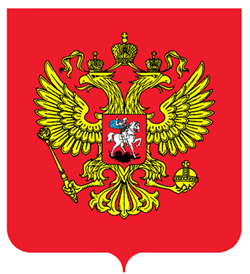
Fig. 9. Drawing an image in a shield on the chest of a two-headed eagle:
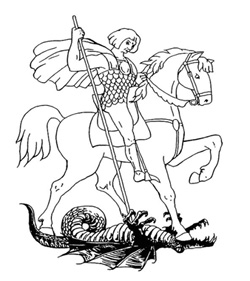
The state emblem is a sign of special importance, a symbol of statehood, the sovereignty of Russia, state power. Therefore, the scope of its use by the federal executive authorities is narrow, and the public authorities of the constituent entities of the Russian Federation are extremely limited. The appearance of the State Emblem should be relatively rare and, therefore, immediately focus the attention of citizens on the fact that a document depicting the emblem, a building on the facade of which has a coat of arms, a sign with a coat of arms are especially important and have national significance.
Given the stringent requirements of the Coat of Arms Act, the established requirements should be strictly observed and the State Emblem should not be used in cases where this is not provided for by law. If in such cases the activities of these bodies require heraldic design, then for this purpose they should be used: for federal executive bodies - departmental emblems, for state bodies of the constituent entities of the Russian Federation - emblems of the respective constituent entities of the Russian Federation.
The Federal Constitutional Law of the Russian Federation “On the State Emblem of the Russian Federation” establishes cases of mandatory and permissible use of the State Emblem.
The use of the State Emblem in cases not provided for by the Law is allowed only by decision of the President of the Russian Federation, drawn up by the relevant Decree of the President of the Russian Federation or if amendments to existing laws are adopted by the established procedure.
2.2.1. MANDATORY CASES OF USE OF THE STATE EMBLEM
For federal executive authorities:
1. The national emblem in a single color image is placed on the forms of the federal executive authorities.
2. The state emblem in a one-color image without a shield is placed on letterhead of bodies, organizations and institutions under the President of the Russian Federation, bodies, organizations and institutions under the Government of the Russian Federation, federal courts, and prosecution authorities of the Russian Federation.
3. The image of the State Emblem is placed on documents of the national standard issued by federal government bodies.
4. The image of the State Emblem is placed on the seals of the federal state authorities.
5. The image of the State Emblem is placed in the offices of the heads of federal executive authorities
(omitted a number of cases established only for the Armed Forces and border support of the Russian Federation).
For public authorities of the constituent entities of the Russian Federation, local government and others:
1. The image of the State Emblem is placed in the offices of the heads of state authorities of the constituent entities of the Russian Federation, heads of municipalities; in the halls of the legislative (representative) bodies of state power of the constituent entities of the Russian Federation, the highest executive bodies of state power of the constituent entities of the Russian Federation, courts of the constituent entities of the Russian Federation, as well as in the halls of the meetings of representative bodies of local self-government and in the halls of ceremonies of bodies carrying out state registration of civil status .
2. The image of the State Emblem is placed on the seals of bodies, organizations and institutions, regardless of ownership, endowed with separate state-power powers, notaries, as well as bodies that carry out state registration of acts of civil status.
3. The image of the State Emblem is placed on documents of a national standard issued by bodies carrying out state registration of acts of civil status, as well as on documents drawn up and (or) issued by notaries.
2.2.2. ALLOWED USE OF THE STATE EMBLEM
For federal executive authorities:
The state emblem of the Russian Federation may be:
1) is placed on insignia and uniforms established for persons who are in the military or other public service;
2) used as the heraldic basis of the emblems of federal executive bodies.
For public authorities of the constituent entities of the Russian Federation:
No permissible cases are provided.
2.2.3. UNACCEPTABLE CASES OF USING THE STATE EMBLEM
Not allowed:
1) abuse of the State emblem;
2) the use of a distorted coat of arms, i.e. coat of arms made in violation of the established description;
3) violation of the rules for placing the State Emblem in combination with other emblems.
For federal executive authorities of the Russian Federation, local government and others:
Not allowed:
1) the identity of the coat of arms of the subject of the Russian Federation, the municipality and any other coat of arms of the State Emblem;
2) the use of the State Emblem as the heraldic basis of the emblems of the constituent entities of the Russian Federation, municipalities, public associations, enterprises, institutions and organizations.
2.3. GENERAL COMMENTS ON THE IMAGE OF THE STATE COAT OF ARMS
The emblems, including state ones, do not have reference images. Within the limits of conformity with the approved description of the coat of arms and the general model given by the image of the coat of arms attached to the law, various artistic and design interpretations are acceptable. However, there are a number of provisions that require strict compliance: the image of the coat of arms, made with their non-compliance, can be considered as an image that does not comply with the law, and if it is entered into official usebeing prosecuted in the prescribed manner.
The following are basic requirements and the most common errors.
1. Compliance with established colors.
The coat of arms can be depicted in a single-color version (a contour of the same color), or in a color version. In the latter case, all established colors must be strictly observed:
The field of the shield and small shield on the eagle’s chest is red;
- an eagle and all its attributes (crowns, ribbon, scepter, orb) - gold (yellow);
- horseman (including his face and hands), horse and spear - silver (white);
- horseman's cloak - blue (blue);
- The dragon is black.
A very common mistake in the production of color images of the State Emblem: in the composition of the coat of arms only two colors are used - red and gold (yellow), the image in the small shield on the chest of the two-headed eagle is not colored in the established order, but is given in gold (yellow) or gold (yellow) on red background. A similar image of the State Emblem should not be allowed in any cases. It is also unacceptable to add colors not indicated in the description to the coat of arms’s image: for example, to paint the eyes of a two-headed eagle differently with gold (yellow), a ribbon combining crowns, etc.
2. Attentive attitude to the image in the shield on the chest of the double-headed eagle.
In the shield on the chest of the double-headed eagle, a horseman depicting a dragon with a spear is depicted. This image is often mistakenly called the image of the Holy Great Martyr and Victorious George and is identified with the coat of arms of Moscow. This provision is incorrect. The horseman of the State Emblem is not an image of St. George and differs from the emblem of Moscow:
- the image of the saint should be accompanied by an attribute of holiness - a halo or the top of a spear in the form of a cross; there are no such elements in the State Emblem;
- the rider of the coat of arms of Moscow has weapons other than the rider of the State Emblem (weapons in this case are a generalized term that includes both the weapon itself and the costume);
- the horse of the rider of the State Emblem stands on three legs, having one front leg raised (while the horse of the Moscow rider rides - that is, it rests only on two hind legs);
- the dragon of the State Emblem is knocked over on its back and trampled by a horse (in the Moscow coat of arms, the dragon stands on four legs and turns back).
In this regard, one should not allow that when using the image of the State Emblem in the shield on the chest of the two-headed eagle, an image of the emblem of the city of Moscow, or another image that does not correspond to the approved one, should be placed.
3. The border around the shield of the State Emblem is unacceptable.
In heraldry, the rim is an independent semantic element that has a lowering value. The coat of arms, whose shield is surrounded by a visible border (a border of a color different from the color of the shield field), is already a different, independent coat of arms. Border - a sign of subordination, some "inferiority." Entering it in the State Emblem is an undeserved downgrade of the State Emblem and can be considered as a distortion of the National Emblem - that is, using it in violation of the requirements of the current legislation.
4. Attention should be paid to the arrangement of attributes in the claws of a two-headed eagle.
The scepter and orb are located in the clutches of the double-headed eagle of the State Emblem. When making images of the State Emblem, it is necessary to pay attention to:
the scepter and power in the claws of an eagle were not replaced by other signs (swords, wreaths, lightning, etc.);
the scepter and power were correctly placed in the paws of the eagle: the scepter was in the right paw of the eagle, the power in the left paw of the eagle.
6. Pay attention to the background on which the image of the State Emblem is placed.
The image of the National Emblem may not be placed against the background of the State Flag of the Russian Federation or the colors of the State Flag, against the background of flags of the constituent entities of the Russian Federation, municipalities, other official flags, against a background that is a colorful, numerous combination of colors and shades, graphic and artistic compositions, applications , installations, etc.
2.4. TECHNICAL ISSUES OF USING THE STATE COAT OF ARMS
but). Colors in heraldry are established by generalized terms: scarlet (red), azure (blue, blue-blue), green, black, gold (can also be depicted yellow), silver (can also be depicted white). In the manufacture of specific images, the entire palette of shades corresponding to each color can be used: for example, red - from blood red to pale scarlet, blue - from dark blue to bright blue, etc. Accordingly, the colors of the National Emblem in the manufacture of specific images may vary in shades.
b) The sizes of the image of the State Emblem are also not set and may vary depending on the purpose for which each specific image of the coat of arms is made.
in). Putting several coats of arms together: legal requirements
According to the Law on the State Emblem, when placing the State Emblem together with other emblems, it is necessary to observe the same requirements as indicated for the national flag:
- the size of the State Emblem may not be less than the size of the emblems located nearby;
- The state emblem may not be lower than the adjacent emblems;
- with an odd number of emblems in a row, the State emblem is located in the center;
- when an even number of emblems are arranged in a row, the State emblem is located to the left of the center (in terms of standing facing the emblems).
2.4.1. PLACING THE STATE COAT OF ARMS ON THE BUILDINGS
The State Emblem of the Russian Federation is located on buildings to indicate the locations of the highest bodies of state power of the Russian Federation:
- the official residence of the President of the Russian Federation;
- Council of the Federation of the Federal Assembly of the Russian Federation;
- State Duma of the Federal Assembly of the Russian Federation;
- Government of the Russian Federation;
- Supreme Court of the Russian Federation;
- Supreme Arbitration Court of the Russian Federation;
- diplomatic and other official representations of the Russian Federation outside the Russian Federation.
The location of the State Emblem is defined on the facade of the building so that it is clearly visible.
2.4.2. ACCOMMODATION OF THE STATE COAT OF ARMS IN THE PREMISES
To indicate power and other official powers officials and bodies The State Emblem of the Russian Federation is located on the premises:
- in the office of the President of the Russian Federation;
- in the meeting rooms of the highest bodies of state power of the Russian Federation;
- in the courtrooms of federal courts;
- in the meeting rooms of legislative (representative) bodies of state power of the constituent entities of the Russian Federation and courts of the constituent entities of the Russian Federation;
- in the meeting rooms of representative bodies of local self-government;
- in the offices of the heads of the highest bodies of state power and other higher state bodies of the Russian Federation;
- in the office of the Head of the Administration of the President of the Russian Federation;
- in the offices of the plenipotentiary representatives of the President of the Russian Federation in federal districts;
- in the offices of the heads of federal executive bodies;
- in the office of the Commissioner for Human Rights in the Russian Federation;
- in the offices of federal judges;
- in the offices of prosecutors;
- in the offices of the heads of state authorities of the constituent entities of the Russian Federation;
- in the offices of the heads of municipalities;
- in the offices of the heads of official missions abroad;
- in the halls of ceremonial ceremonies of bodies recording civil acts.
In necessary cases, joint placement of the State Emblem of the Russian Federation with other emblems and emblems (subjects of the Russian Federation, municipalities, federal executive bodies, other state bodies of the Russian Federation, etc.) is allowed.
When co-placing the State Emblem of the Russian Federation with other emblems and emblems, it is necessary to observe principles similar to the principles of placing and subordinating flags.
In the offices of managers in which the State Emblem is to be placed, the preferred location is the wall behind the head’s workplace, and the coat of arms should be positioned so that it is directly behind and above the head’s workplace.
In the meeting rooms where the State Emblem is to be placed, the preferred location is the wall behind the presidium - its center or the place behind the chairman.
It is inadmissible to place the image of the State Emblem in the stands, with the exception of the stands from which the President of the Russian Federation, the Chairman of the Government of the Russian Federation, plenipotentiaries of the President of the Russian Federation (in the exercise of the official representation of the President of the Russian Federation), federal judges (in the exercise of the powers of a judge), ambassadors, envoys and consuls of the Russian Federation (in the exercise of diplomatic powers), Prosecutor General of the Russian Federation , The Human Rights Commissioner in the Russian Federation, as well as the stands in the halls of the Russian Federation and the State Council of formal meetings of the Federal Assembly.
Section 3. The National Anthem
3.1. GLOSSARY
A hymn is a musical identification mark.
The national anthem is a solemn song performed at all official festivities, as a symbol of state unity.
Gymnology - the doctrine of hymns and songwriters
Gymnographer - hymn writer
Hymns - hymn singers
3.2. FROM THE HISTORY OF THE STATE HYMN OF THE RUSSIAN FEDERATION
In Russia, until the 17th century, during church ceremonies, Orthodox church chants were performed instead of a hymn. In the era of Peter the Great, during all kinds of celebrations, “viva editions” began to be performed - patriotic chants.
Later, the role of the official anthem was played by the oldest Russian “Transfiguration March of Peter the Great”. With this march, Russian troops won their glorious victories. He sounded during the assault on Ishmael (1790), near Borodin (1812).
By the end of the XIX century, the march of the elite regiment of the Russian Empire became the main one in Russia.
Since 1816, the first official national anthem of Russia was the English anthem "God Save the King." Its text was translated by the poet Vasily Zhukovsky and supplemented by several stanzas of Alexander Pushkin. The anthem was called "Prayer of the Russians." Like all hymn hymns, “Prayer” was brief and easy to remember.
The birth of the second official anthem, with which the country has lived for almost a century, is associated with the name of the composer Alexei Fedorovich Lvov. At the direction of Nicholas 1 in 1833 he wrote the music of the Russian national anthem to the words (already different) by Vasily Zhukovsky. For the first time “God Save the Tsar” was played on December 11, 1833 at the Bolshoi Theater.
By decree of Nicholas 1 of December 31, 1833, the anthem "God Save the Tsar" was declared the state and remained the only and official anthem.
Lviv’s simple choral melody was called one of the most beautiful in the world. All genius consisted in the simplicity of form and the power of the idea. The Russian anthem was the shortest in the world - only six lines of text.
After the February Revolution, the French “Marseillaise” played the role of the anthem for a short time.
After the October Revolution and until January 1, 1944, the International was the national anthem of the Soviet Union.
The new anthem, written by Alexander Alexandrov on the basis of his song “The Anthem of the Bolshevik Party” (lyrics by Sergei Mikhalkov and Harold El-Registan), “The International” became a party anthem.
The question of creating an anthem of Russia has been raised more than once. On October 12, 2000, the Presidium of the State Council of the Russian Federation returned to the "problem" of the anthem. At the meeting, it was decided that the State Council will listen to the arrangements of three melodies - “Patriotic Songs” and “Hail” of Mikhail Glinka and the USSR anthem to the music of A. Alexandrov and decide which one is best for the anthem. The majority of the voices spoke out for the anthem of Russia to be played by Alexandrov.
On the eve of 2001, following the requests of Russian citizens, Russian President V. Putin decides to leave the music of A. Aleksandrov with the new text S. Mikhalkov as the Russian anthem.
Russia is our sacred power,
Russia is our beloved country.
Mighty will, great glory
Your property for all time
Glory to our free Fatherland,
The fraternal peoples of the age-old union,
Ancestors given the wisdom of the people!
Glory to the country! We are proud of you!
From southern seas to the polar edge
Spread our forests and fields.
You alone in the world! You are the only one -
God's native land!
Wide scope for dreams and for life
The coming years open to us.
Our loyalty to the Fatherland gives us strength.
It was, it is, and it always will be!
Glory to our Free Fatherland, (...)
***
3.3. BASIC RECOMMENDATIONS FOR THE USE OF THE STATE ANTHEM OF THE RUSSIAN FEDERATION
3.3.1. MUSICAL EDITORS OF AN ANTHEM, WAYS OF PERFORMING AN ANTHEM IN OFFICIAL SITUATIONS
The performance of the anthem in an official situation is its direct performance (by an orchestra, choir, orchestra and choir, an ensemble of musicians, singers or singers and musicians, one performer is an instrumentalist or vocalist) or a broadcast of an audio recording of the anthem (in an orchestra, choir, orchestra-choir, ensemble instrumental , vocal or vocal-instrumental, solo vocal or instrumental performance).
In the official performance of the anthem, the music editorial office must exactly comply with the law.
Instrumental, vocal and vocal-instrumental performance of the anthem are equivalent. In all official situations, a hymn can be performed with or without words.
When a hymn is performed with words, the entire hymn is usually performed in its entirety (three verses with a chorus repeating after each verse). In exceptional cases, it is possible to perform a hymn with words composed only of the first verse and chorus.
When the hymn is performed without words, the intro, verse and chorus are performed. Threefold performance of verses and chorus in the performance of the anthem without words is not applied.
The performance of the anthem by professional musicians or people who do not have professional skills, including the singing of the anthem by people without musical abilities, is an absolutely equivalent and full-fledged performance of the anthem, suitable for use in any official situations.
Official and unofficial performance of the anthem
The official is the performance of the anthem in cases where the anthem performs its symbolic function: it denotes the Russian state, state presence, an event of national importance or national importance. Official cases of performance are all cases described in the Anthem Act, as well as other cases of hymn performance in ceremonial situations, at official and public events, in significant public and private cases.
Unofficial is the performance of the anthem, when the anthem is performed exclusively as a piece of music and does not fulfill a symbolic function: during a musical concert, while listening to a recording in private life, etc. In cases of unofficial performance, musical interpretations of the anthem are allowed, which, however, should not go beyond the generally accepted concepts of morality and morality and tell the performance of the anthem the nature of abuse, disrespect or performance in a situation that is obviously unsuitable for this.
Unofficial is also the performance of the anthem as part of independent musical works - the order of their performance is determined by the President of the Russian Federation.
3.3.2. CASES OF PERFORMANCE OF THE STATE HYMN
Mandatory performance of the National Anthem
At federal state ceremonies and the exercise of public authority by state authorities.
During the ceremony of assuming office of the elected President of the Russian Federation - after taking the oath by the President.
When opening and closing a meeting of the Federation Council and sessions of the State Duma of the Federal Assembly of the Russian Federation.
During meetings and seeing-offs of visiting foreign and state visits of heads of foreign states, heads of international and interstate organizations, other senior foreign representatives (according to the customs of the international protocol).
For government bodies of the constituent entities of the Russian Federation
Upon assuming the post of heads of state authorities of the constituent entities of the Russian Federation.
For local government
Upon assuming the post of heads of local government.
For all citizens, bodies, organizations, institutions and enterprises
During the official ceremony of raising the State flag of the Russian Federation.
For the Armed Forces and other military units
When conducting military rituals - in accordance with the general military regulations.
Possible cases of the performance of the national anthem:
Possible cases are cases where the performance of the anthem is appropriate and desirable, but the decision on its performance or non-performance can be freely taken depending on the situation and circumstances.
Anthem performance is possible:
- at the opening of monuments and commemorative signs;
- at the opening and closing of ceremonial meetings dedicated to public holidays of the Russian Federation;
- during any celebrations held by state bodies (federal and constituent entities of the Russian Federation), local governments, state and non-governmental organizations.
Combination of the National Anthem of Russia with other hymns
If several hymns are performed during one ceremony, the order of their performance is as follows:
At official international and interstate events on the territory of the Russian Federation, in which Russia and a foreign state (states) are equal participants - first the anthem of a foreign state (states) is performed, then the anthem of the Russian Federation;
At events in the territory of the Russian Federation with an international presence in which Russia is the dominant participant, and foreign representatives - guests or observers - the anthem of the Russian Federation is performed, and after it, if convenient and necessary, the anthems of foreign states;
In the performance of the anthem of Russia and the anthem of the subject of the Russian Federation - first the anthem of the Russian Federation is performed, then the anthem of the subject of the Russian Federation;
In the performance of the anthem of Russia and the anthem of the municipality - first the anthem of the Russian Federation is performed, then the anthem of the municipality;
In the performance of the anthem of Russia and another (departmental, corporate) anthem, the anthem of the Russian Federation is first performed, then another anthem.
If several hymns are performed during one ceremony, they can:
Executed directly one after another;
To be performed in the described order, but at intervals during which certain parts of the ceremony take place (for example: during the opening ceremony of the monument, the National Anthem is performed when the cover is removed from the monument, then performances, laying flowers and the ceremony ends with the performance of the anthem of the subject of the federation).
3.3.3. STANDARDS OF BEHAVIOR DURING PERFORMANCE OF THE STATE HYMN
At the official performance of the National Anthem, those present listen to it while standing.
This requirement, of course, does not apply to persons who are unable to stand up or who have difficulty standing up and standing due to a health condition: elderly people, people with disabilities, the sick and injured, as well as young children. It is also not required to get up when performing the national anthem in those cases when standing up can pose a real threat to the life and (or) health of those present.
At the same time, the requirement to listen to the official performance of the anthem while standing extends to those persons who, present at a ceremonial event, perform official or technical duties while sitting (for example, audio broadcast operators, stenographers, journalists, etc.).
The military personnel who are in the official performance of the anthem in the ranks are given the command "Attention!" The servicemen present during the official performance of the anthem are out of order, but in military uniform, with headgear, salute during the entire performance of the anthem, in the absence of headgear without a command, they accept the “Smyrno” stance. The requirement to stand in peace also extends to those servicemen who, present at the official performance of the anthem in military uniform, perform official duties (for example, to protect public order), except in cases emergencyrequiring immediate physical intervention.
Law enforcement officers who are in the official performance of the anthem in uniform without a team take a stand at attention. The requirement to stand quietly also applies to those law enforcement officials who, present at the official performance of the anthem in military uniform, perform official duties to protect public order, with the exception of emergency situations requiring immediate physical intervention.
Civilians and civil servants (including those present at the official performance of the anthem in the official form of clothing) are not required to take any particular stance. Moreover, demands on civilians to stand still while playing the anthem, sometimes found at organized events, in particular in schools and other children's institutions, are unethical and unreasonable. Civilians and civil servants during the official performance of the anthem can take any convenient stance, certain movements are possible that do not interfere with others listening to the hymn. It is appropriate and worthy to give civilian honor to the performed anthem, when civilians present during the performance of the hymn lay their right hand on the heart. However, giving civil honor is an act of free choice of a citizen, to which no one can be forced.
The law and international customs stipulate that when performing the anthem, men must be without hats.
This requirement, however, is not absolute and has a number of exceptions based on the traditions and rights of personal freedoms of citizens.
Military and law enforcement officials who are in the line of performance of the anthem in the ranks, either out of order, but in a military (or, correspondingly, service) uniform in the open, or in a room in which the removal of hats is not showing their heads when performing the anthem.
Those who have a special headdress, the wearing of which is caused by a state of health, do not bare their heads.
It is allowed not to lay bare one’s head in extremely adverse weather, natural or technical conditions, when exposing one’s head during the performance of a hymn can really lead to loss of health, injury or life threatening.
It is allowed not to lay bare the head to persons whose religious convictions regard the bare of the head as an act of disrespect and (or) humiliation.
At the same time, the requirement to bare your head while performing the hymn extends:
On civil servants who are in the performance of the anthem in uniform;
- for persons who are present at the official performance of the anthem perform official or technical duties (for example, audio broadcast operators, stenographers, journalists, etc.).
In the official performance of the anthem, silence should be observed and movement and movement reduced to the minimum possible.
It is unethical to talk while the anthem is playing, to actively move without actually having to do so, to turn around, be distracted by extraneous duties, or to be present while playing the hymn with headphones in your ears (with the exception of those who perform technical duties with headphones, or wear headphones or the like subjects for health reasons).
If the performance of the National Anthem is accompanied by the raising of the National Flag, those present turn to face the flag being hoisted.
If the raising of the flag does not accompany the performance of the anthem, then those present turn to face the central point of the events. If there is one already raised (set) flag or one image of the State Emblem, then they turn to face this flag or coat of arms, respectively.
- At the official performance, the National Anthem should be listened to silently or singing along to the performance.
To be silent or sing during the performance of the national anthem is the subject of a citizen's free choice. It is unacceptable to force one to sing a hymn if a citizen does not have a desire, which is often found in children and schools. It is equally unacceptable to restrict a person’s right to sing a hymn if he wants to. Ethics suggests that a citizen who wants to sing a hymn sings in an undertone, not blocking the sound of the performed anthem with his voice, and without attracting the decisive attention of those around him.
All requirements for behavior during the performance of the National Anthem of Russia equally apply to the performance of national anthems of other countries.
Disrespectful attitude to the anthems of other countries, performed officially, should be considered as disrespect for Russia, allowing the performance of these hymns in their own the territory, and, accordingly, the state symbols of Russia - including its anthem.
Performance of national anthems during sports competitions
The practice of performing national anthems during sporting events is determined by established international customs. The following are most common.
- In international competitions
In team sports with national teams, the national anthems of the two countries participating in the game are performed before or (which happens much less often) after the end of the game. In this case, the first anthem of the country, which is considered as a guest, and the second is the anthem of the country, which is considered the owner of the playground.
IN individual species sports (as well as team non-playing sports) after the end of the competition, when the winners are awarded national anthem the country whose athletes took first place (while the flags of all countries whose representatives took first, second and third place are raised - at the same level, or with some difference in height: the flag of the first place is higher, the flag of the second in the middle, the flag of the third is lower )
- When competing within one country
Russian state symbolism has many centuries, during which it repeatedly changed its appearance, but did not change its semantic meaning. Today it is the trinity of the coat of arms, flag and anthem, reflecting the greatness, invincibility and unity of the people of our nation. The symbols of the Russian Federation are truly unique and cause a special, reverent attitude of all the multinational peoples of Russia.
RUSSIAN FLAG
The history of the origin of the flag of Russia
Birth time state russian flagit is considered to be the 17-18th century, the time when Russia became an increasingly powerful state. The tricolor flag was raised for the first time under Tsar Alexei Mikhailovich, it happened on one of their warships with the name "Eagle". However, the “Eagle” did not have long to sail under this banner, after some time it was burned by the peasants of Stepan Razin.
The official founder of the tricolor flag is Peter the Great. Thanks to his decree of January 20, 1705, it was necessary to raise the white-blue-red flag on all vessels engaged in trade, while Peter himself made a sample of the flag himself and indicated the order of the alternation of colors.
Often three-way russian flag it was possible to observe on many warships until the St. Andrew flag appeared in 1712.
Imperial black-yellow-white flag of Russia
Under Emperor Alexander II with state colors russian flag began to consider white, orange and black. It was such a tricolor that should be used for decoration during the holidays and other special occasions.
The imperial black-yellow-white flag existed in Russia until 1883 until the time when Emperor Alexander III ordered not to decorate the buildings in various special occasions with a flag representing a cloth of stripes of white, blue and red.
Approval of the Russian tricolor
Later, in 1896, the last Emperor Nicholas II and the Special Meeting established by his order, created at the Ministry of Justice, discussed the issue of the Russian national flag and decided to continue to consider white, blue and red colors to be national, and the flag of these three colors as a national flag.
Then they got an official interpretation of color russian flag. According to it, the red color means "Sovereignty", blue is the color of the Mother of God, who patronizes Russia, and white is freedom and independence. In addition to this, the colors of the Russian flag also signified the community of three Russia - White, Small, Great.
Red flag
In 1917, the Provisional Government did not abandon the tricolor flag, but continued to count it. Only in April 1918, Sverdlov was proposed as national flag use the red banner. The red flag lasted more than 80 years.
Return to tricolor
The red revolutionary flag was abandoned at the initiative of deputy Yaroshenko. It was he who suggested returning to the tricolor. At the Extraordinary Session of the Supreme Council in August 1993, it was decided to consider the tricolor flag national. And on August 20, 1994, a decree was issued that established that the state flag should always be on the Presidential Administration and the buildings where the federal state and executive authorities are located.
In 1994, in the month of August, the Russian flag appeared on its own holiday. President B.N. Yeltsin established to celebrate it in August, the 22nd day, on the day of its official restoration and because of its centuries-old glory and to educate the younger generation of respect for all state symbols.
In January 1998, it was decided not to consider issues related to state symbols, since there are different points of view on this issue both in society and in parliament.
However, in December 2000, President Putin submitted to the State Duma, along with other bills on state symbols, a draft law “On the State Flag”. On December 8, this bill was adopted by the State Duma immediately in the first and final, third, readings. After the approval of the law by the Federal Assembly of the Russian Federation, it was signed by the president. This happened on December 25, 2000.
Image of the Flag of Russia and its interpretation
According to this law state flag of Russia it is a rectangular-shaped panel of three identical horizontal stripes of the lower - red, middle - blue and upper - white. The size of the flag is such that its width refers to its length as 2: 3. The colors of the flag of Russia do not have an official interpretation, however, the following interpretation is very common. The white color of the flag means peace and purity, perfection and integrity, blue is faith and loyalty to the Fatherland, and red indicates the strength of the Russian people and symbolizes the blood shed during the defense of the Fatherland.
 COAT OF ARMS OF RUSSIA
COAT OF ARMS OF RUSSIA
The coat of arms of the Russian Federation
State emblem of Russia, according to this Law, it is a quadrangular heraldic shield sharpened at the tip, bright red in color, with rounded lower corners, which depicts a golden 2-headed eagle, raising its spread wings. His heads are crowned with the first big and 2 small crowns, which are connected by a ribbon. At the same time, the eagle in its right paw holds the scepter, and in the left - the power. The bright red shield located on the eagle’s chest depicts a silver horseman wearing a blue cloak. The horseman, being on a silver horse, which rides to the left side, strikes with the help of a silver spear the black dragon, which is overturned and trampled by his horse, which is also turned to the left.
The value of the elements of the Coat of Arms of Russia
The image of the golden 2-headed eagle on a bright red background preserves in its color scheme the historical continuity of the emblems that were in our state during the late 15-17 centuries. The drawing of the eagle originates from images on those monuments that are characteristic of the era of Peter the Great. The historical crowns of Great Peter (in the amount of three pieces), which are depicted above the eagle, under the new conditions symbolize nothing more than the sovereignty of not only the entire Russian Federation as a whole, but also its individual parts (i.e., subjects of Russia). The scepter and power, which holds the eagle in its paws, personify a single Russian state, as well as state power in the country. The fact that there is a rider on the chest of the eagle, who strikes the dragon with the help of a spear, is one of the oldest symbols of constant struggle, as well as the obligatory victory of good over evil, light over dark, reliable defense of the Fatherland.
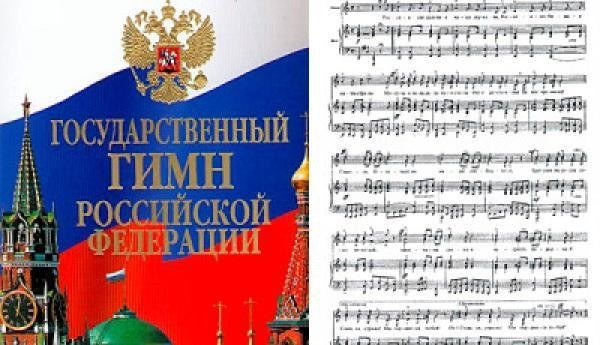 Hymn R OSSII
Hymn R OSSII
Russian anthem, like a coat of arms and a flag, is the most important official symbol of the state. Milestones in the history of the modern anthem of Russia were not unambiguous, like the history of the state itself.
An interesting fact is the birth of the present Anthem of Russia. In many respects, athletes contributed to this, expressing dissatisfaction with the fact that, when awarded at world-class arenas, to sing, due to the lack of words, they simply have nothing. Hence the intensity of patriotism feels a certain imbalance, the mood for achieving new victories is not the same. President Putin announced a competition, the result of which was the approval of old music inherited from the USSR, and a slightly modified text with verses by Mikhalkov. It is under this anthem that all events of sovereign importance are held, athletes are awarded for it, it sounds for a great country every morning.
Historical facts about the national anthem of Russia
Until 1816, a hymn in its modern sense did not exist - solemn events were accompanied by the singing of a church choir. In the time of Peter I, patriotic military marches sounded, which gained quite a lot of popularity among the population. The first anthem of Russia was borrowed from the British, the words laid on the music were written by Vasily Zhukovsky. It was not without his participation that the hymn “God Save the Tsar!”, Written so far, was written - written by Alexei Lvov and partially corrected by Zhukovsky (some lines were changed so that the text harmonizes with the music).
Further story Anthem of Russia underwent changes, as well as the chronology of events of the state itself. After the overthrow of the Tsar in 1917, the bourgeois Workers' Marseillaise, which was supplanted by the proletarian International, was in awe.
It was after him that the origins of the modern anthem of Russia begin.
Many still remember how solemnly the Anthem of the Soviet Union sounded. The great country, rising from the ruins of World War II, needed a symbol of statehood that would fully reflect the greatness of the sovereign. In 1944, a new anthem appeared, to the sounds of which the power gained power and developed over half a century. The words, as well as the music for the anthem, Stalin personally claimed. Among hundreds of applicants, approval was received by Alexander Alexandrov (music) and Sergey Mikhalkov in collaboration with Gabriel El-Registan (text design).
The uncertainty and turmoil of the nineties of the last century are fully reflected in the Patriotic Song. The paradox of this new anthem of Russia was the lack of words - only music sounded at national events. A decade accompanied by a “song without words” ended in the year 2000.

What are state symbols and how did they arise.
state symbols.
Each state has its own distinctive symbols in the form of a coat of arms, flag and anthem. They are called state symbols.
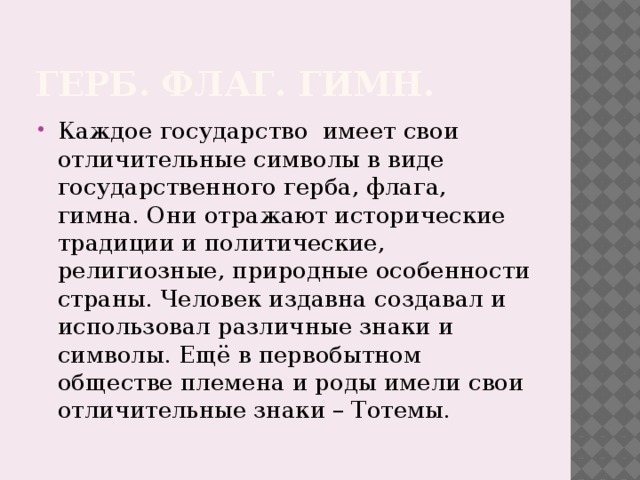
Coat of arms. Flag. Anthem.
- Each state has its own distinctive symbols in the form national emblem, flag, anthem. They reflect historical traditions and political, religious, natural features of the country. Since ancient times, man has created and used various signs and symbols. Even in primitive society, tribes and clans had their distinctive signs - Totems.
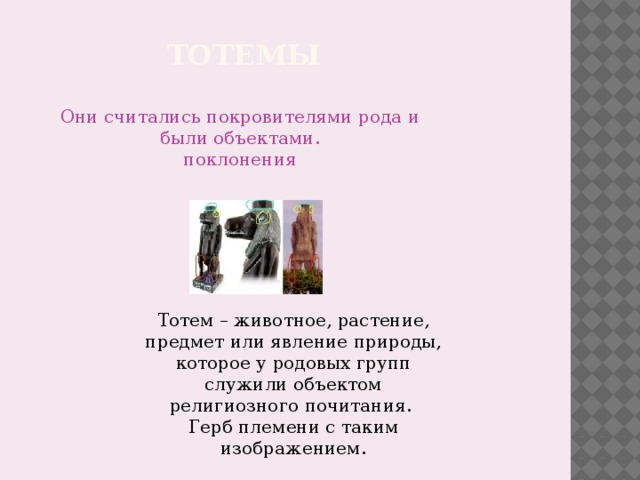
Totems
They were considered the patrons of the clan and were objects.
worship
A totem is an animal, plant, object or natural phenomenon that has served as an object of religious veneration in tribal groups.
Coat of arms of a tribe with such an image.

- The emblem (from the Greek emblema-insert, embossed decoration) is the embodiment of the phenomenon. The image of a real object in an emblem most often comes down to a sign and acquires conventional schematic forms. (For example, emblems of various military branches) In the ancient world, emblems are found on coins, seals, and medals. In ancient Egypt there was a snake, and in ancient Athens there was a snake. Later, emblems began to be placed on banners and armor. In ancient Rome, each military unit had its own emblem in the form of some kind of animal.
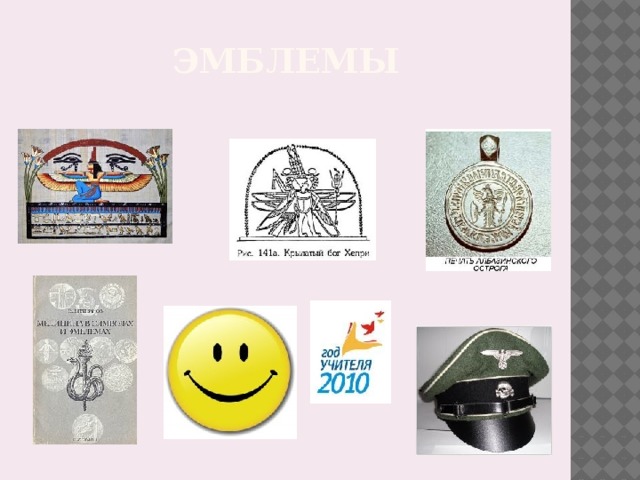
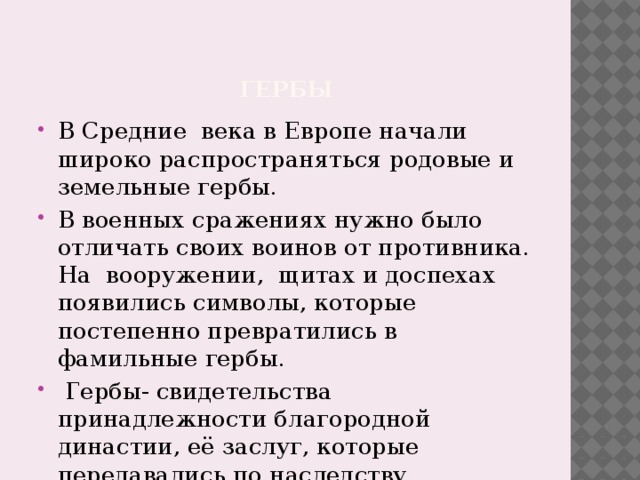
Coats of arms
- In the Middle Ages, tribal and land coats of arms began to spread widely in Europe.
- In military battles it was necessary to distinguish their soldiers from the enemy. In arms, shields and armor, symbols appeared that gradually turned into family coats of arms.
- Coats of arms - evidence of belonging to a noble dynasty, its merits, which were inherited.

Family coat of arms of King Richard the Lionheart
At the beginning of the xii century. The English crawl Richard the Lionheart began to use the image of three golden lions, which are still symbols of the British royal dynasty and adorn the shield on the coat of arms of Great Britain, as a family coat of arms.
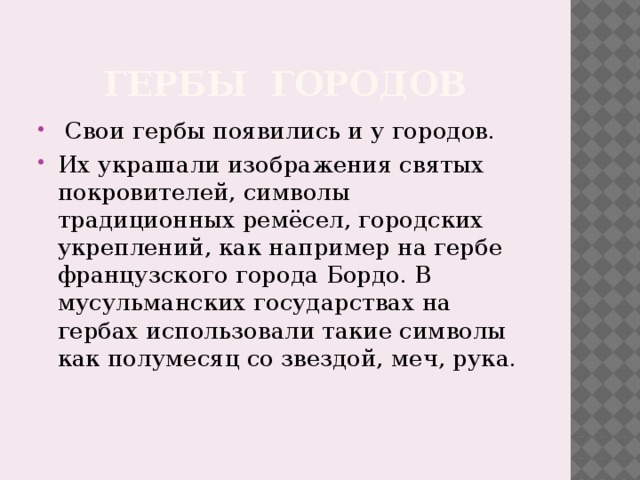
Coats of arms of cities
- Coats of arms also appeared in cities.
- They were decorated with images of patron saints, symbols of traditional crafts, city fortifications, such as on the coat of arms of the French city of Bordeaux. In Muslim states, symbols such as a crescent with a star, a sword, and a hand were used on the arms.
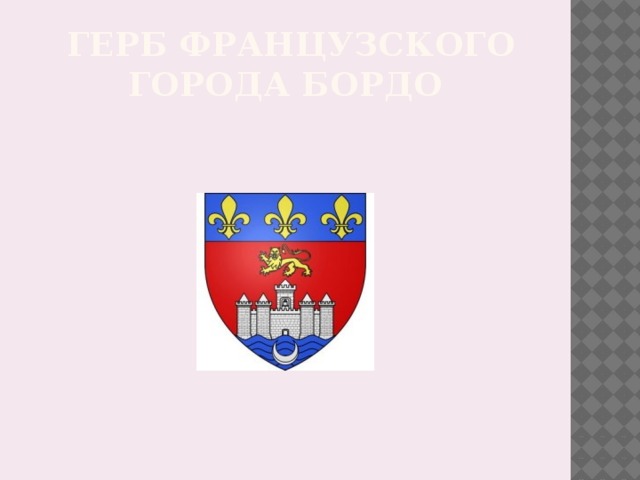
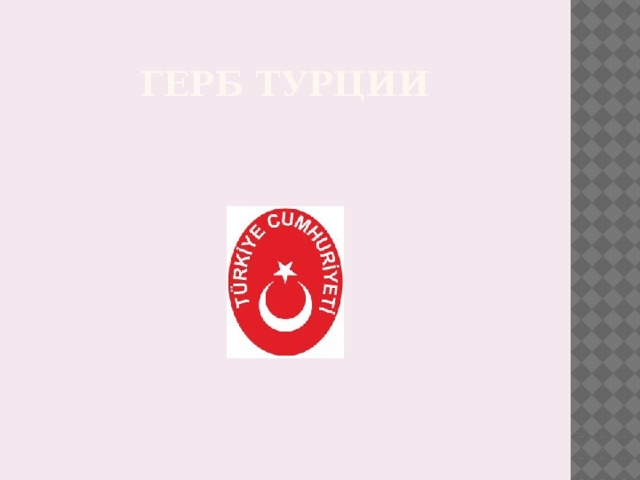
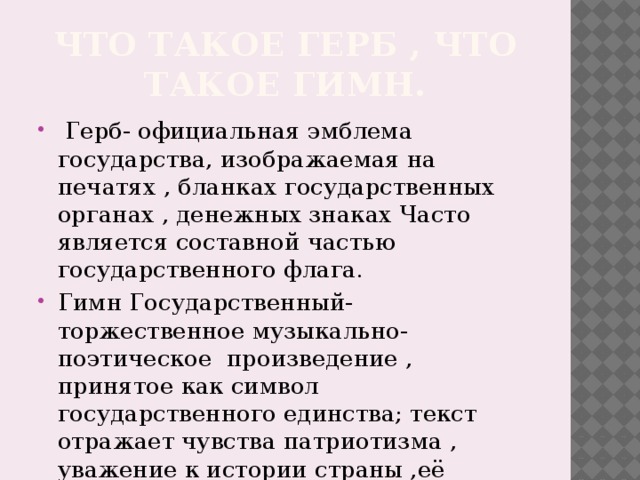
What is a coat of arms, what is a hymn.
- Coat of arms - the official emblem of the state, depicted on seals, letterheads of state bodies, banknotes It is often an integral part of the national flag.
- The National Anthem is a solemn musical and poetic work, adopted as a symbol of state unity; the text reflects feelings of patriotism, respect for the country's history, its state system.
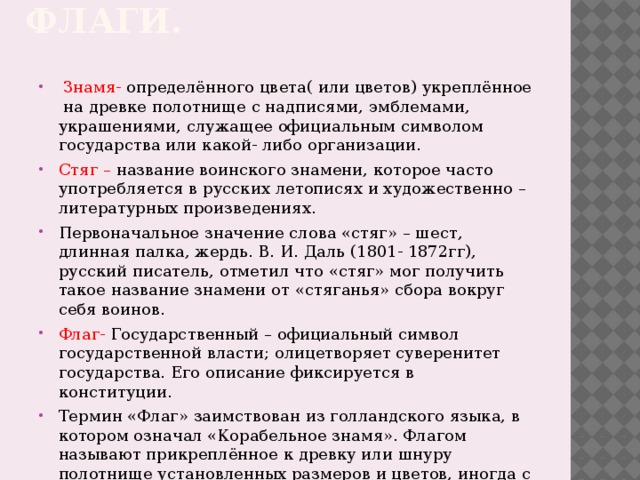
Banners. Banners. Flags
- A banner is of a certain color (or colors), a panel fixed on a pole with inscriptions, emblems, decorations, serving as an official symbol of the state or any organization.
- Banner - the name of a military banner, which is often used in Russian chronicles and fiction.
- The original meaning of the word “flag” is a pole, a long stick, a pole. V. I. Dahl (1801–1872), a Russian writer, noted that a “banner” could have received such a banner’s name from a “banner” of gathering soldiers around it.
- Flag - State - official symbol state power; personifies the sovereignty of the state. Its description is fixed in the constitution.
- The term “Flag” is borrowed from the Dutch language, which means “Ship's banner”. A flag is a flag attached to a pole or cord, in fixed sizes and colors, sometimes with a coat of arms, an emblem on it.

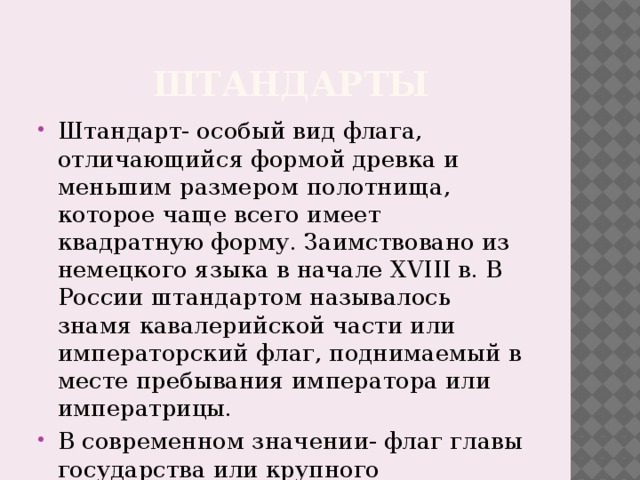
Standards
- The standard is a special type of flag, characterized by the shape of the flagpole and the smaller size of the cloth, which most often has a square shape. Adopted from the German language at the beginning of the XVIII century. In Russia, the standard was called the banner of the cavalry unit or the imperial flag, hoisted at the place of residence of the emperor or empress.
- In modern value flag Head of state or major military leader.
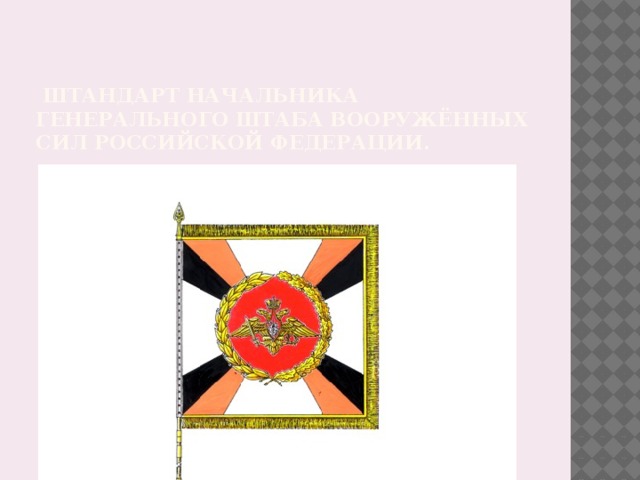

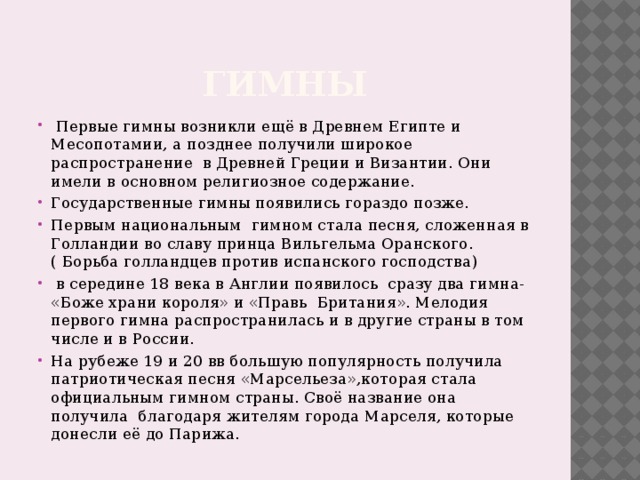
Hymns
- The first hymns arose in ancient Egypt and Mesopotamia, and later became widespread in ancient Greece and Byzantium. They had mostly religious content.
- National anthems appeared much later.
- The first national anthem was a song composed in Holland to the glory of Prince William of Orange. (The Dutch fight against Spanish domination)
- in the middle of the 18th century in England two hymns appeared at once - “God Save the King” and “The Right of Britain”. The melody of the first anthem spread to other countries, including Russia.
- At the turn of the 19th and 20th centuries, the patriotic song “Marseillaise” became very popular, which became the country's official anthem. It got its name thanks to the inhabitants of the city of Marseille, who brought it to Paris.

Anthem of Ancient Egypt
- You shine beautifully in the sky, a vibrant sun disk that laid the foundation for life!
- You rise in the eastern horizon and you fill the whole earth with your beauty!
- You are beautiful, great, luminous and high above the whole earth!
- Your rays embrace the country right up to the limit of all that you have created!
- You [are] Ra and you reach their [countries] limits!
- You subordinate them to your beloved son! 3
- You are far away, and your rays are on the earth, [for] you are in front of [them to be seen?] Your passage!
- You enter the western horizon, and the earth [is] in darkness, like the dead
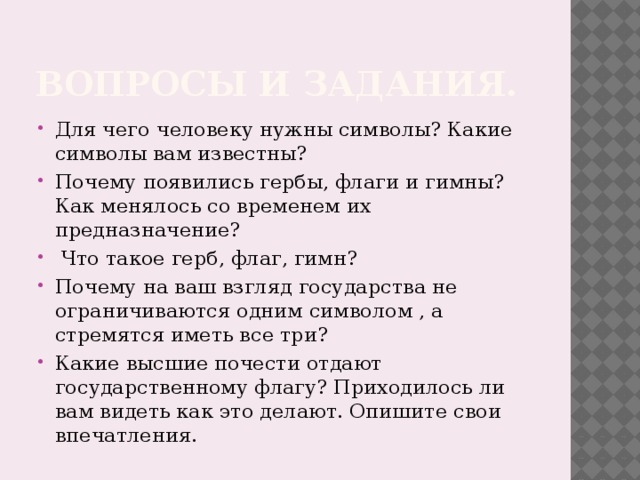
Questions and tasks.
- Why do people need symbols? What characters do you know?
- Why did coats of arms, flags and hymns appear? How did their purpose change over time?
- What is a coat of arms, flag, anthem?
- Why do you think states are not limited to one symbol, but strive to have all three?
- What are the highest honors national flag? Have you ever seen how they do it. Describe your impressions.
- The training system according to the Dalton plan - the organization of the educational process - Sergei V. Sidorov
- Internal differences, specialization of individual cities
- Consonant and letter th
- Not a single word: whom to work after philology
- Warning flags on the beach
- Abstract of speech therapy classes in elementary school
- Sound and Alpha Word Analysis

 Live journal
Live journal Facebook
Facebook Twitter
Twitter